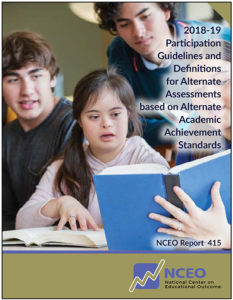 NCEO has released a report titled 2018-19 Participation Guidelines & Definitions for Alternate Assessments based on Alternate Academic Achievement Standards.
NCEO has released a report titled 2018-19 Participation Guidelines & Definitions for Alternate Assessments based on Alternate Academic Achievement Standards.
This report provides an updated review of 2018-19 state criteria and guidelines for participation of students with the most significant cognitive disabilities in alternate assessments based on alternate academic achievement standards (AA-AAAS). Policies were pulled from state assessment administration manuals, accessibility manuals, participation guidelines, state education agency websites, state-developed AA-AAAS materials for parents, and professional development material for educators. The materials were analyzed by the following themes:
- Criteria for AA-AAAS participation
- Factors not to use in decision making
- How states define students with significant cognitive disabilities
Current policies are compared to those from a 2017 analysis to examine change over time. There are several key findings. First, there was no substantial change over time in the top AA-AAAS participation criteria, the criteria not to be used to determine AA-AAAS participation or in the definition of students with the most significant cognitive disabilities. Across states, the most frequently mentioned criteria remained: (a) significantly affected cognitive and adaptive function; (b) extensive individualized instruction or supports; and (c) alternate or modified curriculum standards. The most common criteria states required IEP teams not to use in participation decisions were: (a) disability label, placement, or service; (b) social, cultural, linguistic or environmental factors; and (c) excessive absences. Not all states had an explicit definition of a student with a significant cognitive disability, but of those that did the most common components were “significant cognitive deficits”, and “poor adaptive skill level”.
As the number of AA-AAAS resources on state websites have increased, the topics covered by participation policies have expanded to include information for parents or guardians, English learner considerations and AA-AAAS exemption. The report provides an analysis of these new themes as well. For example, it describes the extent to which states explicitly addressed parents or guardians in AA-AAAS participation decision-making forms and procedures, as well as the information that educators need to share with parents (e.g., potential effects of AA-AAAS participation on a student’s diploma options). Further, some state policies addressed criteria used for alternate assessments of English language proficiency and related them to the criteria for participation in AA-AAAS. Finally, a few state policies addressed whether to exempt students from AA-AAS if they had extraordinary or medical circumstances or lacked a reliable form of communication.
Additional sections of the report address whether there are substantive differences between some states’ definitions of students with the “most significant” cognitive disabilities and other states’ definitions of students with “significant” cognitive disabilities and provide a summary of the growing body of training materials and tools to help local IEP teams make AA-AAAS participation decisions.
